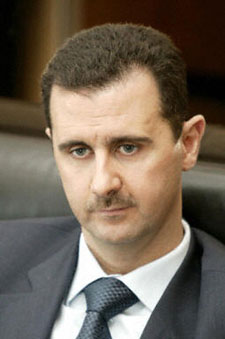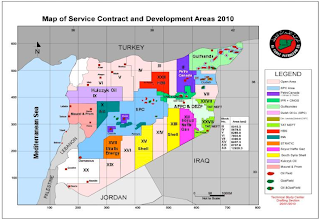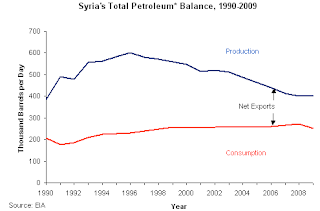
This article was last updated on May 19, 2022
Canada: ![]() Oye! Times readers Get FREE $30 to spend on Amazon, Walmart…
Oye! Times readers Get FREE $30 to spend on Amazon, Walmart…
USA: ![]() Oye! Times readers Get FREE $30 to spend on Amazon, Walmart…
Oye! Times readers Get FREE $30 to spend on Amazon, Walmart…
 Syria has been in the news for weeks now and it is very rare that there is any mainstream media coverage of the country’s oil and gas industry. The issue did appear recently when Secretary of State Hillary Clinton stated that:
Syria has been in the news for weeks now and it is very rare that there is any mainstream media coverage of the country’s oil and gas industry. The issue did appear recently when Secretary of State Hillary Clinton stated that:"…We urge those countries still buying Syrian oil and gas, those countries still sending Assad weapons, those countries whose political and economic support give him comfort in his brutality, to get on the right side of history…".
In light of her comments, I thought it prudent to examine just how much oil and natural gas Ms. Clinton is speaking of. As I will outline in this posting, while its production of oil and natural gas is not large when compared to many of its Middle East neighbours, Syria is, in fact, currently the only producer of oil and natural gas among the nations on the eastern shore of the Mediterranean Sea.
Syria’s first oil production began in 1968 with most of the current oil production being located along the Euphrates Graben in the northeastern part of the country. Here is a map showing the location of the Euphrates Graben:
Here is a map showing the contract areas and oil and gas fields in Syria:
For my Canadian readers, please note the participation of PetroCanada in the northeastern most part of the country.
According to the Energy Information Administration (EIA), Syria produced around 400,000 BOPD of combined oil and natural gas liquids in 2009 and 213 BCF of natural gas in 2008. Syria’s oil production had been in a state of decline for a decade and a half since peaking at 583,000 BOPD back in 1996. Recent successful development drilling, new discoveries and field rehabilitation are expected to increase production capability and put a halt to production declines. Over the past 2 years alone, an additional 50,000 BOPD of productive capability has been added and in 2010, an additional 15,000 to 20,000 BOPD was expected to come on stream from new discoveries by Indian and Russian oil companies. According to the Organization of Arab Petroleum Exporting Countries (OAPEC), Syria has 3 billion barrels of oil reserves (0.26 percent of the world’s total and 0.46 percent of OAPEC’s total).
Oil production and development are managed by the Syrian Petroleum Company (SPC), an offshoot of the Ministry of Petroleum and Mineral Resources. Foreign oil companies have been offered a share of Syria’s oil industry in an attempt to stem the country’s production decline with formation of the Al-Furat Petroleum Company. This joint venture is 50 percent owned by SPC, 32 percent by Shell Oil and China’s CNPC. China is also active in other parts of Syria through its Sinochem and Sinopec government oil companies.
In the first quarter of 2011, SPC produced 1,7385,626 barrels and 1,133,354 thousand cubic metres of natural gas. The company also drilled 49185 metres of hole. As well, SPC has announced that it is offering another Bid Round for three offshore blocks in the Mediterranean Sea with a closing date of October 5th, 2011. As well, the Ministry of Petroleum and Mineral Resources is inviting qualified companies to explore for and develop Syria’s oil shale deposits.
For the past 2 decades or more, Syria has consumed less oil than it has produced. Domestic consumption has risen slowly over the past 2 decades from 200,000 BOPD to 263,000 BOPD in 2006 and 308,000 BOPD in 2010 according to OPEC statistics. As shown in this chart, Syria has exported up to 400,000 BOPD back in 1996; this has declined to 149,000 BOPD in 2010, again according to OPEC:
Most of Syria’s oil exports are shipped to European OECD nations including Germany, Italy and France. In all cases, Syrian oil imports provide a very small portion of each countries daily oil needs.
Syria is estimated to have proven natural gas reserves of 8.5 trillion cubic feet (Tcf), half of which is associated with oil reservoirs. Gas that is non-associated is found in the central and eastern part of the country. In 2008, Syria produced 208 billion cubic feet (Bcf) of natural gas and consumed 213 Bcf. Recent large discoveries have increased gas production to 361 Bcf per year by mid-2010 and it is expected to reach 412 Bcf per year by the end of 2010.
Approximately 35 percent of Syria’s natural gas production was injected into oil reservoirs in an attempt to boost oil production with the bulk of the remainder used domestically for power production and industrial usage. According to the EIA, Syria plans to substitute natural gas for oil by 2014 for both power production and industrial usage since Syria does not have the refining facilities necessary to produce refined oil for these purposes. With Syria now producing more natural gas than it consumes, it is exporting small volumes to both Lebanon and Turkey.
As we can see, Syria’s overall oil and natural gas production is rather insignificant when compared to other Middle East nations, particularly nations such as Libya. While Syria does export a small volume of oil to Europe, those importing nations could easily substitute oil from other sources for their supply of Syrian imported crude. Perhaps this explains why there has been reluctance on the part of both Europe and America to get involved in Syria’s domestic affairs; there simply is no economic reason to involve oneself as there is in the case of Libya. More’s the shame.
Click HERE to read more of Glen Asher’s columns.
Article viewed on:Oye! Times at www.oyetimes.com.
You can publish this article on your website as long as you provide a link back to this page.




Be the first to comment